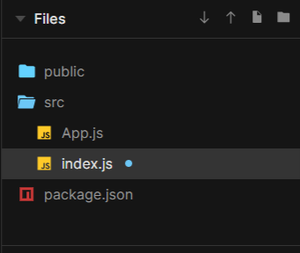React Native AppRegistry
正如我们所知,组件是一个返回一些JSX的JavaScript函数。但是这些组件不能自行运行,我们必须注册它们以便在我们的设备上渲染。我们必须明确告诉React Native一个入口点,从那里它应该开始渲染。
这个入口点是通过“AppRegistry”来指定的。AppRegistry帮助我们注册React Native应用程序的入口点。我们必须在我们的React应用程序中至少注册一个组件。
先决条件:
- 具备ReactJS和React Native的基本知识。
- NodeJs应该已经安装在您的系统上。
- 具备HTML,CSS和JS的基本知识。
让我们通过一些示例来看一下AppRegistry的用法。
创建应用程序:
请按照以下步骤创建一个应用程序:
步骤1:
当您的终端打开时,执行以下命令将安装expo-cli。
npm install -g expo-cli
步骤2: 现在通过以下命令创建一个项目。
expo init Project
步骤3: 现在进入项目文件夹,即 Project 文件夹
cd Project
项目结构: 项目的结构应该如下所示:

示例1: 在索引.js中,我们将创建一个函数式组件并使用AppRegistry进行注册。myComponent是一个简单的组件,在屏幕上返回消息“Hello World!学习AppRegistry!”。
import React from "react";
import { AppRegistry, StyleSheet, Text, View }
from "react-native";
// import Constants from 'expo-constants';
// code for myComponent which is showing Hello World
function myComponent() {
return (
<View style={styles.container}>
<Text style={styles.fontStyle}>
Hello World! Learning AppRegistry!!!!
</Text>
</View>
);
}
// Styles for Text and view
const styles = StyleSheet.create({
container: {
flex: 1,
justifyContent: 'center',
textAlign: 'center',
backgroundColor: '#ecf0f1',
padding: 8,
},
fontStyle: {
margin: 24,
fontSize: 30,
fontWeight: 'bold',
textAlign: 'center',
},
});
// "project" is the name of the main react-native Folder
// the second argument is an arrow function
// returning myComponent defined above
AppRegistry.registerComponent("project", () => myComponent);
// runApplication() loads the javascript bundle and runs the app.
AppRegistry.runApplication("project", {
rootTag: document.getElementById("root")
});
运行应用程序的步骤: 打开终端并输入以下命令。
npm start
输出:

为了定义我们应用的入口点,我们使用了AppRegistry.registerComponent()
AppRegistry.registerComponent("folderName", () => componentName);
- 第一个参数: “folderName” 是主要的react-native应用程序名称
- 第二个参数: 是返回你想要在设备上渲染的组件的函数。
注册组件的步骤:
- 从react-native导入AppRegistry
- 创建一个组件
- 使用AppRegistry.registerComponent()函数将组件注册到AppRegistry。
- runApplication() 加载javascript包并运行应用程序。
示例2: 让我们在单独的文件中创建一个单独的组件,并在index.js文件中注册它。App.js默认导出一个函数组件,该组件返回“Hello World!! Using AppRegistry”。
import React from "react";
import { StyleSheet, Text, View } from "react-native";
function App() {
return (
<View style={styles.app}>
<View style={styles.header}>
<Text style={styles.code}>
Hello World !! Using AppRegistry
</Text>
</View>
</View>
);
}
// Styles for Text and View components
const styles = StyleSheet.create({
app: {
marginHorizontal: "auto",
maxWidth: 500
},
header: {
padding: 20
},
code: {
fontFamily: "monospace, monospace",
fontSize: 30
}
});
export default App;
index.js
import App from "./App";
import { AppRegistry, StyleSheet, Text, View }
from "react-native";
// "project" is the name of the main react-native Folder
// the second argument is an arrow function returning
// App, which is imported above
AppRegistry.registerComponent("project", () => App);
// runApplication() loads the javascript bundle
// and runs the app.
AppRegistry.runApplication("project", {
rootTag: document.getElementById("root")
});
输出:

 极客教程
极客教程